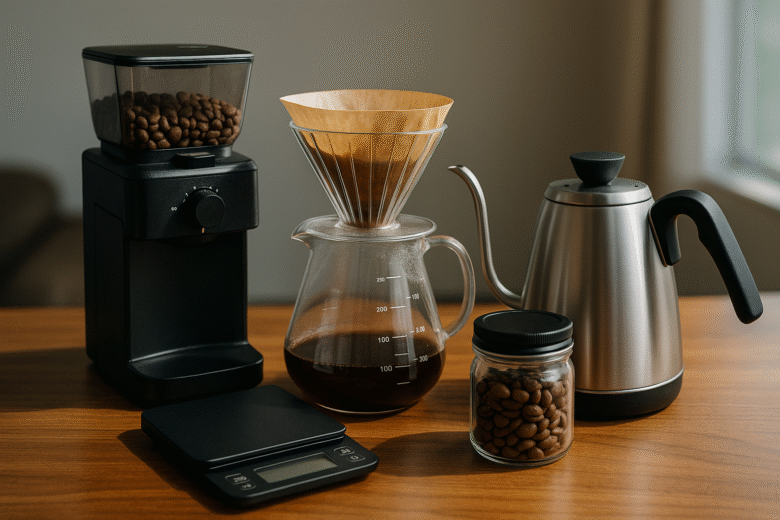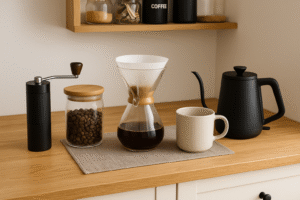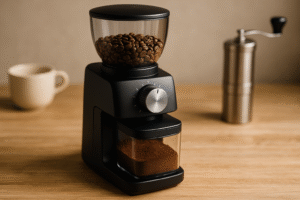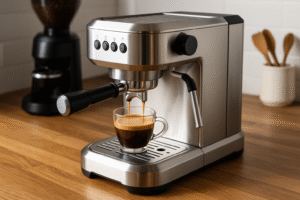When you’re starting to brew coffee at home, choosing the right equipment makes all the difference. Two of the most popular and beginner-friendly options are the French Press and the AeroPress.
Both are affordable, portable, and easy to use—but they produce very different results.
If you’re wondering which method suits your taste, lifestyle, and brewing goals, this article will help you understand the key differences and guide you to the right choice.
Understanding the French Press
The French Press is a classic full-immersion brewer. It typically consists of a glass or stainless steel cylindrical carafe with a plunger and metal mesh filter.
To use it, you combine coarsely ground coffee with hot water, let it steep, and then press the plunger to separate the grounds from the liquid.
This method extracts a rich, bold, and full-bodied cup. The metal filter allows some fine particles and oils to remain in the final brew, giving it more texture and depth.
French press coffee is ideal for people who enjoy a strong, flavorful cup with a heavier mouthfeel.
Understanding the AeroPress
The AeroPress is a modern, compact brewing tool made of plastic. It uses pressure to extract coffee and offers a hybrid method between immersion and filtration.
The device consists of two cylinders that fit together to create a vacuum-sealed chamber. You place a paper or metal filter at the base, add coffee and water, and press the plunger down to force the brew through the filter.
AeroPress coffee is smooth, clean, and lower in acidity. It’s excellent for making single servings and can mimic espresso-like intensity with the right technique.
It’s ideal for those who like clean cups, flexibility, and fast cleanup.
Brew Time Comparison
French press coffee typically takes around 4 to 5 minutes from start to finish, with a steep time of about 4 minutes.
AeroPress, on the other hand, is much quicker. You can brew a cup in under 2 minutes, especially with the inverted method or standard recipes.
If speed is important—such as during busy mornings—the AeroPress has the advantage.
However, the French press suits those who enjoy a slower, more relaxed brewing process.
Flavor and Mouthfeel
French press coffee is rich and heavy, with noticeable body and texture. It carries coffee oils and micro-grounds that create a denser feel.
This makes it great for darker roasts or bold single-origins where body and depth matter.
AeroPress delivers a cleaner, lighter cup with less sediment. It excels with medium or light roasts and can bring out brighter, more nuanced flavors.
If you enjoy tasting subtle notes—like citrus, florals, or chocolate—AeroPress might be the better fit.
Ease of Use
Both methods are easy to learn, but the French press is slightly more forgiving. It requires fewer steps and doesn’t need much technique once you understand the ratio and timing.
The AeroPress has more flexibility but also more variables. You can adjust grind size, water temperature, stir time, and pressure.
This makes it fun for tinkerers but may overwhelm complete beginners who prefer simplicity.
That said, plenty of easy recipes exist for the AeroPress, and once you find one you like, it’s very straightforward.
Cleanup Process
Cleaning a French press involves rinsing the metal filter and removing the coffee grounds from the carafe. Some people find this messy, especially if grounds get stuck in the mesh.
AeroPress cleanup is one of its most-loved features. After pressing, you simply remove the cap and pop the compact puck of used grounds into the trash or compost. Rinse and you’re done.
For those who value quick, no-fuss cleanup, the AeroPress wins hands down.
Portability and Travel
The AeroPress was made for travel. It’s lightweight, durable, and fits in a backpack or suitcase. Many travelers, campers, and remote workers swear by it.
French presses, especially glass ones, are heavier and more fragile. While travel-sized stainless steel versions exist, they’re bulkier than an AeroPress.
If you’re often on the go, the AeroPress offers unmatched convenience.
Capacity and Serving Size
The standard AeroPress brews about 8 ounces (237ml) at a time, though you can stretch it with the bypass method or do multiple brews.
The French press comes in various sizes, from single-cup to 1-liter models. It’s better for brewing multiple cups at once.
If you usually make coffee for more than one person, or want to prepare a batch for yourself in one go, the French press is more practical.
Cost and Accessories
Both brewers are budget-friendly. You can find a good French press for $20–$40, and an AeroPress for around $30–$35.
French presses don’t require filters, which lowers long-term cost. AeroPress needs paper or metal filters, which are inexpensive but still an ongoing supply.
Optional accessories for both include better grinders, thermometers, or scales—but neither requires them to start.
Customization and Flexibility
The AeroPress offers more flexibility. It supports dozens of recipes, including inverted and standard methods. You can tweak pressure, time, and temperature for different results.
There’s even an AeroPress World Championship, highlighting its versatility and cult following.
The French press is more consistent in style. Once you find your preferred ratio and steep time, you’ll get similar results each brew.
Choose AeroPress if you love experimentation. Stick with French press if you value reliability and simplicity.
Sustainability and Environmental Impact
French press is more eco-friendly by default. It uses a metal mesh filter, so there’s no need for disposable paper.
AeroPress users can reduce waste by using a reusable metal filter or composting paper filters.
Both devices are durable and don’t require electricity, making them low-impact overall.
Summary of Pros and Cons
French Press Pros:
- Bold, rich flavor with full body
- Makes multiple cups
- Simple technique
- No disposable filters needed
French Press Cons:
- Can leave sediment in cup
- Cleanup can be messy
- Less portable
AeroPress Pros:
- Clean, smooth taste
- Fast brew and cleanup
- Great for travel
- Highly customizable
AeroPress Cons:
- Brews one cup at a time
- Requires filters
- Learning curve for some methods
Conclusion: Choose What Fits You
If you want a rich, full-bodied brew, often serve more than one cup, and prefer a traditional style—go for the French Press.
If you value clean taste, quick brewing, minimal cleanup, and portability—the AeroPress is your match.
There’s no wrong choice—only the right one for your habits, preferences, and coffee goals. Either way, you’ll be stepping into a better brew at home.

Marcio Luzardo is a coffee enthusiast and the voice behind Tudo Viraliza. With a passion for turning curiosity into practical knowledge, he shares easy-to-follow tips, guides, and insights to help readers enjoy better coffee every day. When he’s not writing, Marcio is exploring new brewing methods or diving into the rich stories that connect coffee to culture, lifestyle, and wellness.



